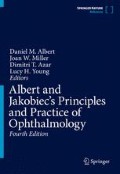Abstract
This chapter describes retinal diseases presenting in childhood. Emphasis is placed on key characteristics of each entity that are useful for the pediatric ophthalmologist. Categories include tumors, retinal vascular diseases, macular lesions, and congenital abnormalities. Two of the more common causes of infectious chorioretinopathies in children, toxoplasmosis and toxocariasis, are also reviewed. Retinoblastoma and retinopathy of prematurity are more fully discussed in Chaps. 317, “Staging and Grouping of Retinoblastoma” and 266, “Retinopathy of Prematurity.”
Access this chapter
Tax calculation will be finalised at checkout
Purchases are for personal use only
References
Foster BS, Mukai S. Intraocular retinoblastoma presenting as ocular and orbital inflammation. Int Ophthalmol Clin. 1996;36:153–60.
Materin MA, Shields CL, Shields JA, Eagle RC. Diffuse infiltrating retinoblastoma simulating uveitis in a 7-year-old boy. Arch Ophthalmol. 2000;118:442–3.
Morgan G. Diffuse infiltrating retinoblastoma. Br J Ophthalmol. 1971;55:600–6.
Kiribuchi K, Uchida Y, Fukuyama Y, Maruyama H. High incidence of fundus hamartomas and clinical significance of a fundus score in tuberous sclerosis. Brain Dev. 1986;8:509–17.
Robertson DM. Ophthalmic manifestations of tuberous sclerosis. Ann N Y Acad Sci. 1991;615:17–25.
Gass JD. New observations concerning choroidal osteomas. Int Ophthalmol. 1979;1:71–84.
Shields CL, Sun H, Demirci H, Shields JA. Factors predictive of tumor growth, tumor decalcification, choroidal neovascularization, and visual outcome in 74 eyes with choroidal osteoma. Arch Ophthalmol. 2005;123:1658–66.
Grossniklaus HE, Thomas JW, Vigneswaran N, Jarrett WH. Retinal hemangioblastoma. A histologic, immunohistochemical, and ultrastructural evaluation. Ophthalmology. 1992;99:140–5.
Gauthier D, D’Amico DJ, von Mukai S. Hippel-Lindau disease. Int Ophthalmol Clin. 2001;41:173–87.
Webster AR, Maher ER, Moore AT. Clinical characteristics of ocular angiomatosis in von Hippel-Lindau disease and correlation with germline mutation. Arch Ophthalmol. 1999;117:371–8.
Vianna RN, Pacheco DF, Vasconcelos MM, de Laey JJ. Combined hamartoma of the retina and retinal pigment epithelium associated with neurofibromatosis type-1. Int Ophthalmol. 2001;24:63–6.
Blumenthal EZ, Papamichael G, Merin S. Combined hamartoma of the retina and retinal pigment epithelium: a bilateral presentation. Retina. 1998;18:557–9.
Theodossiadis PG, Panagiotidis DN, Baltatzis SG, Georgopoulos GT, Moschos MN. Combined hamartoma of the sensory retina and retinal pigment epithelium involving the optic disk associated with choroidal neovascularization. Retina. 2001;21:267–70.
Mason JO, Kleiner R. Combined hamartoma of the retina and retinal pigment epithelium associated with epiretinal membrane and macular hole. Retina. 1997;17:160–2.
Kahn D, Goldberg MF, Jednock N. Combined retinal-retina pigment epithelial hamartoma presenting as a vitreous hemorrhage. Retina. 1984;4:40–3.
Otani T, Yamaguchi Y, Kishi S. Serous macular detachment secondary to distant retinal vascular disorders. Retina. 2004;24:758–62.
Lee ST, Friedman SM, Rubin ML. Cystoid macular edema secondary to juxtafoveolar telangiectasis in Coats’ disease. Ophthalmic Surg. 1991;22:218–21.
Gupta MP, Talcott KE, Kim DY, Agarwal S, Mukai S. Retinal findings and a novel TINF2 mutation in Revesz syndrome: clinical and molecular correlations with pediatric retinal vasculopathies. Ophthalmic Genet. 2017;38:1–10.
Walton DS, Mukai S, Grabowski EF, Munzenrider JE, Dryja TP. Case records of the Massachusetts General Hospital. Case 5-2006. An 11-year-old girl with loss of vision in the right eye. N Engl J Med. 2006;354:741–8.
Koulisis N, et al. Correlating changes in the macular microvasculature and capillary network to peripheral vascular pathologic features in familial exudative vitreoretinopathy. Ophthalmol Retina. 2019;3:597–606.
Hsu ST, et al. Macular microvascular findings in familial exudative vitreoretinopathy on optical coherence tomography angiography. Ophthalmic Surg Lasers Imaging Retina. 2019;50:322–9.
van Nouhuys CE. Juvenile retinal detachment as a complication of familial exudative vitreoretinopathy. Fortschr Ophthalmol Z Dtsch Ophthalmol Ges. 1989;86:221–3.
Nishimura M, et al. Falciform retinal fold as sign of familial exudative vitreoretinopathy. Jpn J Ophthalmol. 1983;27:40–53.
Kashani AH, et al. High prevalence of peripheral retinal vascular anomalies in family members of patients with familial exudative vitreoretinopathy. Ophthalmology. 2014;121:262–8.
Kondo H. Complex genetics of familial exudative vitreoretinopathy and related pediatric retinal detachments. Taiwan J Ophthalmol. 2015;5:56–62.
Nikopoulos K, et al. Next-generation sequencing of a 40 Mb linkage interval reveals TSPAN12 mutations in patients with familial exudative vitreoretinopathy. Am J Hum Genet. 2010;86:240–7.
Rao F-Q, et al. Mutations in LRP5,FZD4, TSPAN12, NDP, ZNF408, or KIF11 genes account for 38.7% of Chinese patients with familial exudative vitreoretinopathy. Invest Ophthalmol Vis Sci. 2017;58:2623–9.
Salvo J, et al. Next-generation sequencing and novel variant determination in a cohort of 92 familial exudative vitreoretinopathy patients. Invest Ophthalmol Vis Sci. 2015;56:1937–46.
Goldberg MF. Classification and pathogenesis of proliferative sickle retinopathy. Am J Ophthalmol. 1971;71:649–65.
Goldberg MF. The blinding mechanisms of incontinentia pigmenti. Ophthalmic Genet. 1994;15:69–76.
George ND, Yates JR, Moore AT. Clinical features in affected males with X-linked retinoschisis. Arch Ophthalmol. 1996;114:274–80.
Eksandh LC, et al. Phenotypic expression of juvenile X-linked retinoschisis in Swedish families with different mutations in the XLRS1 gene. Arch Ophthalmol. 2000;118:1098–104.
Apushkin MA, Fishman GA, Janowicz MJ. Correlation of optical coherence tomography findings with visual acuity and macular lesions in patients with X-linked retinoschisis. Ophthalmology. 2005;112:495–501.
Azzolini C, Pierro L, Codenotti M, Brancato R. OCT images and surgery of juvenile macular retinoschisis. Eur J Ophthalmol. 1997;7:196–200.
Fishman GA, et al. Visual acuity in patients with best vitelliform macular dystrophy. Ophthalmology. 1993;100:1665–70.
Shields JA. Ocular toxocariasis. A review. Surv Ophthalmol. 1984;28:361–81.
Gilbert RE, Stanford MR. Is ocular toxoplasmosis caused by prenatal or postnatal infection? Br J Ophthalmol. 2000;84:224–6.
Holland GN. Reconsidering the pathogenesis of ocular toxoplasmosis. Am J Ophthalmol. 1999;128:502–5.
Author information
Authors and Affiliations
Corresponding author
Editor information
Editors and Affiliations
Section Editor information
Rights and permissions
Copyright information
© 2022 Springer Nature Switzerland AG
About this entry
Cite this entry
Nudleman, E., Nagata, T., Mukai, S. (2022). Retinal Lesions Presenting in Childhood. In: Albert, D.M., Miller, J.W., Azar, D.T., Young, L.H. (eds) Albert and Jakobiec's Principles and Practice of Ophthalmology. Springer, Cham. https://doi.org/10.1007/978-3-030-42634-7_280
Download citation
DOI: https://doi.org/10.1007/978-3-030-42634-7_280
Published:
Publisher Name: Springer, Cham
Print ISBN: 978-3-030-42633-0
Online ISBN: 978-3-030-42634-7
eBook Packages: MedicineReference Module Medicine

